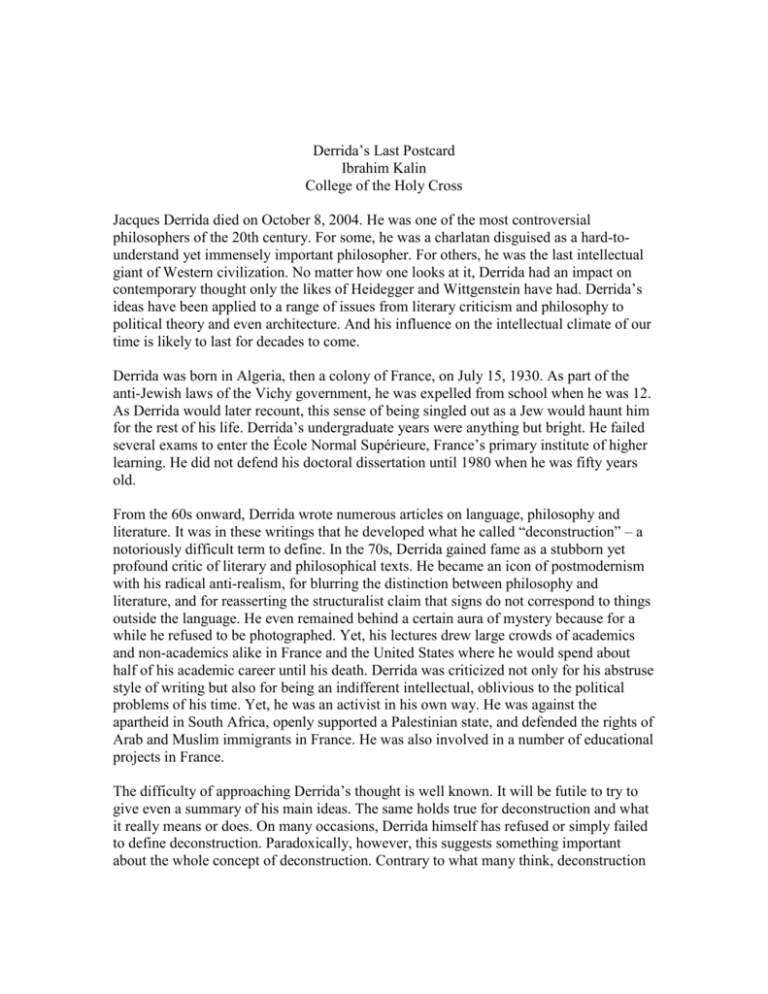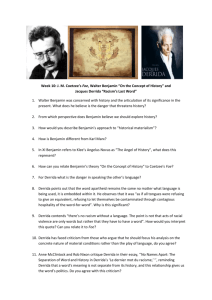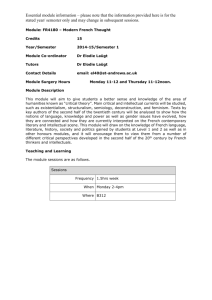Jacques Derrida - Islamic Philosophy Online
advertisement

Derrida’s Last Postcard Ibrahim Kalin College of the Holy Cross Jacques Derrida died on October 8, 2004. He was one of the most controversial philosophers of the 20th century. For some, he was a charlatan disguised as a hard-tounderstand yet immensely important philosopher. For others, he was the last intellectual giant of Western civilization. No matter how one looks at it, Derrida had an impact on contemporary thought only the likes of Heidegger and Wittgenstein have had. Derrida’s ideas have been applied to a range of issues from literary criticism and philosophy to political theory and even architecture. And his influence on the intellectual climate of our time is likely to last for decades to come. Derrida was born in Algeria, then a colony of France, on July 15, 1930. As part of the anti-Jewish laws of the Vichy government, he was expelled from school when he was 12. As Derrida would later recount, this sense of being singled out as a Jew would haunt him for the rest of his life. Derrida’s undergraduate years were anything but bright. He failed several exams to enter the École Normal Supérieure, France’s primary institute of higher learning. He did not defend his doctoral dissertation until 1980 when he was fifty years old. From the 60s onward, Derrida wrote numerous articles on language, philosophy and literature. It was in these writings that he developed what he called “deconstruction” – a notoriously difficult term to define. In the 70s, Derrida gained fame as a stubborn yet profound critic of literary and philosophical texts. He became an icon of postmodernism with his radical anti-realism, for blurring the distinction between philosophy and literature, and for reasserting the structuralist claim that signs do not correspond to things outside the language. He even remained behind a certain aura of mystery because for a while he refused to be photographed. Yet, his lectures drew large crowds of academics and non-academics alike in France and the United States where he would spend about half of his academic career until his death. Derrida was criticized not only for his abstruse style of writing but also for being an indifferent intellectual, oblivious to the political problems of his time. Yet, he was an activist in his own way. He was against the apartheid in South Africa, openly supported a Palestinian state, and defended the rights of Arab and Muslim immigrants in France. He was also involved in a number of educational projects in France. The difficulty of approaching Derrida’s thought is well known. It will be futile to try to give even a summary of his main ideas. The same holds true for deconstruction and what it really means or does. On many occasions, Derrida himself has refused or simply failed to define deconstruction. Paradoxically, however, this suggests something important about the whole concept of deconstruction. Contrary to what many think, deconstruction is not a method or another technique of reading texts. It is not just another conceptual tool with which we decipher the meaning of a text. It rather consists of a number of assumptions about language, reality and what occurs at the intersection of the two. How language evades any easy formulations and what this means for us humans is the fundamental given of deconstruction. In this sense, deconstruction is not even a philosophy but rather an insight and/or intuition into the reality of what is constructed through language in the countless forms of novels, poems, philosophical treatises, oratories, political speeches, histories, and so on. A safe way to approach Derrida and deconstruction is therefore to look at some of these assumptions that underlie Derrida’s thought. It should be remembered that Derrida worked within a post-structuralist framework. According to this, signs have a functional meaning only within the matrix of binary relations that they have with others. Signs have meaning not because they somehow correspond to something real or fundamental but rather emerge within a network of binary oppositions, differences and contrasts that make up any given language. Such terms as black and white, hot and cold have meaning only when they are seen in relation to one another. What is important, however, is that the principle of binary oppositions is not confined to words in language. It applies to such central concepts of human thought as truth and falsehood, good and evil, beauty and ugliness, and so on. An important outcome of this analysis is what Derrida calls logo-centrism, i.e., the claim that all (true) knowledge is rooted in a transcendent signifier that essentially remains outside and beyond the binary oppositions within which signs are found. This transcendent signifier can be God, the Idea, the Self, the Spirit, Being, or class struggle in the case of Marx. It is the foundation par excellence of all thought, culture, language, and value judgments that we bring to the world. It is also the ground for the binary oppositions with which we construct reality. In a broad sense, these binaries include such ‘master oppositions’ as good/evil, spiritual/physical, divine/human, reason/unreason, and so on. In all of these contrasts, a hierarchy of terms is maintained, and what is lower is pushed to the margin and presented as no more than a ‘supplement’. Now, Derrida is interested in these margins and supplements. Deconstruction is a program, so to speak, to dismantle the hidden layers of meanings in a text (for Derrida, anything that claims to say something is a text), and show its utter contingency and arbitrariness. It aims at demolishing the logo-centric biases of a text by dissolving the binary oppositions that underlie and regulate it. The goal is to dissolve the conceptual hierarchies that emanate from the logo-centrism of a particular text. At the end, each text is shown to undercut its own assumptions, and forced to admit its inability to produce a self-authenticating foundation. Deconstruction rejects any vantage point from which we can understand and represent reality. Every attempt to pin down the meaning of a text is undermined by its own logic, inconsistencies, fluidity, and ‘deference of meaning’. In short, what Derrida is saying is that a text always evades us. We cannot lay claim to reality as Western thought has tried to do through its logo-centrism. We cannot encircle even what we consider to be reality for us. The construction of a text is such that there is always something that is left out, remains unsaid, resists clarity, and forces us to look for what appears to be a mere supplement or footnote to the main text. In a sense, we can only speak in terms of negations. The moment we think we have cracked at the meaning of a text, we are ordered to face the ‘other’ of what we have just done because our newly born deconstruction always runs the risk of becoming a construction in and of itself. There is no way out of this ‘infinite interplay of signifiers’. We can only admit it, and perhaps learn patiently and humbly to live with it. This may sound too presumptuous or simply a pedantic way to avoid serious philosophical work. But in reality what all of these amount to is what the medieval philosophers via Plotinus and Proclus called via negativa. In philosophical theology, via negativa asserts that there is always more to God than what we can say of Him. Similarly, there is always more to God than what His creation reveals of Him. If God is infinite, then He can be known neither empirically nor conceptually because both of these forms of knowledge would entail putting limits on an infinite being. In this sense, the Absolute is ‘incomprehensible’, i.e., the human comprehension falls short of capturing it. If this is admitted, then we have to be always cautious about what we affirm or say of God. This, however, does not suggest that we can say nothing about God. What it suggests is that we have to guard ourselves against the temptation of attempting a ‘master definition’ of God and claiming to have the final word about it. Via negativa is like the Hindu neti neti (“not this, not this” or “neither this, nor that”): it warns us against the conceptual trap of falling for what appears to be real at first sight, and invites us to reject or ‘defer’ it for that which is yet to be actualized. All of these come surprisingly close to what deconstruction seeks to do. That is perhaps why Derrida was personally interested in this aspect of negative theology. No theology is possible without some level of via negativa. In the Islamic tradition, the Muslim theologians (mutakallimun) fought vigorously to defend the transcendence of God (tanzih) against the danger of anthropomorphism (tashbih). The Mu’tazilites in particular were adamant in safeguarding God’s absolute transcendence to the point of explaining away His names and qualities in terms of the various modes and states of His Essence. Yet, emphasizing the pole of transcendence at all costs is not without its perils. Presenting God as the utterly other runs the risk of cutting Him off from the world He has created. An absolutely transcendent God with no relation to this world can easily become a ‘regulatory principle’ rather than a divine being to whom we pray, whom we love, and whose friendship we seek. What this means is that pure negation is never sufficient. To use the symbolism of the Islamic testimony which says la ilaha illa Allah (there is no god but God), saying “la” (no) without saying “illa” (but) does not deliver. A believer says “la” to all false deities to be able to say “illa” to only one God. From this point of view, Derrida seems to be stuck with the station of “la”! Ibn al-‘Arabi, the great Sufi metaphysician of the 13th century from Andalusia, has an interesting solution for this. He believes that neither the defenders of transcendence nor the advocates of immanence do justice to God. Taken in itself, each invites metaphysical error and theological impropriety. Instead, he proposes the position of what he calls a “true believer”. For Ibn al-‘Arabi, a true believer is the one who sees God with two eyes (dhu’l-‘aynayn). With one eye, he sees God as utterly transcendent, remote, sublime, dissimilar. At this level, God is the mysterium tremendum and beyond all comprehension, utterance, description. Here He is the Lord to be worshipped. But the same believer sees God with his other eye as here and now, always present and intimately linked to His creation. At this level, God is “closer to us than our jugular vein”. Here He is the supreme friend, the Beloved of all lovers, the center towards which every thing moves, the light that illuminates the whole cosmos. According to Ibn al-‘Arabi, it is only by seeing God with two eyes that we can do justice to His transcendence-cum-immanence. Seeing God with two eyes does not lead to duality because we see things with two eyes. Yet what we see is not two but one. In short, via negativa cannot be our only refuge. An infinite play of deconstructions may offer us some illuminating and even liberating perspectives. But it does not enable us to find a home in a world of homeless minds, uprooted traditions, and soul-less masses. Derrida’s cry of neti neti a la deconstruction is a commendable call for rejecting what we are presented with in the name of a modern civilization. Yet, we need more than just a “no” if we are to survive the insanities of our world.








